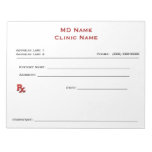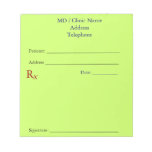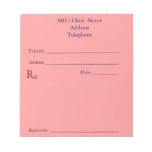Introductory videos reduce patient anxiety
People look for physicians who are qualified to treat their medical issues. But, even more so, they look for physicians they like and can see themselves having a positive relationship with. When they visit your website or see your practice on social media, they're typically not asking where you went to medical school or the accolades you've earned. Instead, they want to know if you're friendly and trustworthy. And they want to see if you'll be empathetic and caring when they're most vulnerable.
That's why videos introducing you and your practice make a difference. On video, people can hear your voice and see your face. They can see how you talk about complex issues and what having you as their doctor might be like. Ultimately, a video introduction is more memorable and makes a stronger impression than just text on a bio page.
To make an introduction video, create a slide deck and talk as you go through the slides. This can be quickly recorded on Zoom and published on YouTube or your website.
Build relationships before the first appointment
Your staff and assistants are the people your patients spend most of their time interacting with. No matter how good the doctor is—the staff can make or break their experience at your office.
I suggest creating videos with your staff. Include your office manager and receptionist. Interview the staff members with whom your patients will speak the most. Show them that you're a great practice because you have a great team that cares about your patients and wants them to have a positive experience.
A great staff and supporting team can differentiate you from other practices. The video instantly connects potential new patients, encouraging them to trust your practice. This video can be uploaded to your website or sent to them before they visit with a "New Patient Welcome Packet."
Give viewers a tour of your office
While you introduce yourself and your staff on the video, could you show them your office? A tour of your office is a chance to show your staff at work, introduce your services, familiarize potential patients with your space, and create an atmosphere of an approachable practice.
Video tours help potential patients learn about your practice and reduce anxiety. They also help patients understand what to expect when they schedule an appointment.
Video tours work well for your homepage to show website visitors what to expect when they visit the office. If you have multiple offices, you can make a short video of each location and put it in the Locations section of your website.
Using testimonials from existing patients
Happy patients will often tell others about their experiences with you. So, along with text-based testimonials and a favorable review profile, add video testimonials to your marketing mix. Of course, this requires the patient's permission.
Even a few testimonial videos can be powerful conversion tools for your practice. New patients are already looking at your online reviews and asking friends and family if they've ever heard of you. A video testimonial is more compelling because it is more authentic than a text-based review and gives happy patients a chance to tell their stories.
You can use those testimonials in the appropriate section on your website. For example, it's good to get testimonial videos of what you enjoy seeing in your office. If you enjoy shockwave therapy and orthotics, get a testimonial about the treatments you offer and put the video in that section of your website. You could also repurpose the video by sending it to your patient email newsletter.
Videos to educate patients about conditions and treatments
Before people look for a physician online, they tend to research their symptoms and learn more about what happens when they see a doctor. That's why it's important to educate potential clients, explain common symptoms and causes, and discuss possible treatment options. If you're the practice with answers when they need them, you'll also be the practice they choose when they're ready to make an appointment.
Videos are the unrivaled medium for explaining complex topics. Whether using props, recording while you draw on a whiteboard, or talking viewers through an on-screen infographic, video brings your issues to life. It improves the amount of information viewers retain after watching. You can use these videos alone or as visual aids alongside written content, and you can share them on social media sites to expand your reach and get potential patients interested in your practice.
Explain what to expect
Along with the educational videos, you should show people their treatment. For example, patients might think that "laser treatment" or "shockwave therapy" sounds scary or painful, and it can be challenging to picture the treatment just from reading it. A short video showing you performing laser treatment can put people at ease and give them a better idea of what to expect.
In my practice, patients are asked to give a urine specimen. They were informed they would be asked to provide a specimen and hydrate before coming to the office. This simple information reduces patients' waiting in the reception area or the exam room to furnish a specimen.
Similarly, intake videos can be a great way to ensure patients come to their appointments prepared. Whether you use video with your website's appointment-scheduling chatbot or send out a video to help patients prepare for a procedure, your videos help your patients have a favorable opinion about working with you and become confident in their choice.
Create videos for social media
Your website is a great place to post your videos. Static text posts and graphics are easy to ignore; most people click off the website and eliminate your text posts.
So, the next time you're trying to come up with ideas for a new campaign or wondering what to post on Facebook, try video. For the most part, these can be short videos, in the five—to seven-minute range, that get right to the heart of the service you're promoting and speak directly to your potential patients.
This is also a place where the magic of video editing can play a part. A great video editor can help you break up longer videos, add on-screen elements and calls to action, and create perfect videos that are easy to share and quick to watch. You can save time and money by repurposing your existing videos for social media or ad campaigns. Your audience gets interesting content that raises practice awareness and compels them to click through and make an appointment.
Videos to promote webinars and recorded live events
Consider putting together an educational webinar or recording video at any live events, such as seminars or educational programs your practice participates in with your local community.
For example, we have conducted webinars with the doctors in our office on infertility and prostate cancer. These were live, recorded, and used online as patient resources for those who could not attend.
Creating a video when you're in the community or hosting charitable events is also a great idea. For example, a few clips of your staff educating people at a local health fair or collecting donations for a food drive are perfect for humanizing your practice and showing that you care about your local community.
Getting started recording videos
You may be intimidated or think making videos is costly or time-consuming. If you have a smartphone, you are ready to start. When starting, you will get a simple ring light that holds your phone and starts the video. One of the easiest ways of finding topics is to write down every question a patient asks you during the day. Then, record a short 1–2-minute video going over that question.
Authenticity vs. polished videos
Patients and those viewing online content prefer authentic and valuable videos rather than polished ones. You are not trying to become the next YouTube influencer but to educate and attract your ideal patient. With your video, try to connect with your patients and use abundant stories of similar patients you have seen. This will create trust between you and the viewers even before you see them in the office.
One excellent way to make videos is to have your staff record you in a treatment room with a patient. Remove the patient from the video and have them record that you are explaining the typical conditions you see in the office, such as plantar fasciitis, Achilles tendonitis, or how to prepare for surgery. These videos are excellent as they can be shown to patients with similar questions.
Suggestions for video creation
Here are a few tips when creating videos:
- Make them informal and personal.
- Comply with HIPPA considerations.
- Procure signed permission releases (even from providers and staff).
- Keep it short (under two minutes).
- Keep the topics as evergreen as possible.
- Use patient-friendly language (not medical jargon).
- Make it relatable by showing emotion and empathy.
- Optimize the format for mobile phone viewing.
- Be sure to use search engine optimization (SEO) so it will be found online.
- Promote it and repurpose it across all digital channels.
Using videos in practice
You might be unsure where to use your videos once you make them, but here are a few options. Remember, you do not need to post the video, but one of your staff or a virtual assistant can help you with the operational side of using it once you make it.
- Website - Answer common patient questions.
- Website - Record video formats of presentations on each condition you treat in the office.
- Website - Demonstrate "how-to's" such as dressing changes and stretching.
- Website - Include meeting the doctor or staff videos with short videos.
- Social Media - Give your opinion about a current news event.
- Social Media - Introduce a new procedure or equipment.
- Social Media - Show a behind-the-scenes or funny sneak peek of something in your office.
- Social Media - Make an inspirational or motivational video for patients.
- Social Media - Share a success story from a patient on a standard treatment.
Here is a sample video by a podiatrist entertaining with a magic trick.
Here is a humorous video discussing vasectomy.
Bottom Line:
Today, we are challenged to provide quality care efficiently and cost-effectively. This is a concern for every practice regardless of size and location, whether it is a solo or extensive group practice or an academic or private practice. Using patient videos, we can improve our efficiency and productivity, maintain quality of care, improve patient compliance, and even improve outcomes. So, get ready for lights, camera, and action.
Medical Office Supplies
15% Off All Products

Manual Prescription Pad (Large - White) Memo Pad

Manual Prescription Pads (Light Blue) Notepads

Manual Prescription Pads (Light Yellow) Notepad

Manual Prescription Pads (Light Pink) Notepad


 Manual Prescription Pad (Large - Yellow)
Manual Prescription Pad (Large - Yellow)









